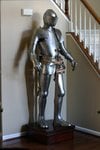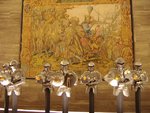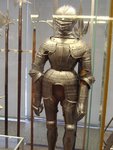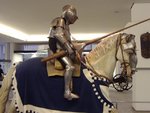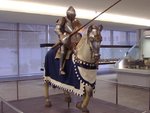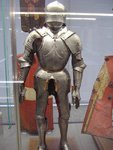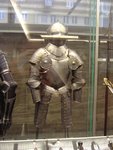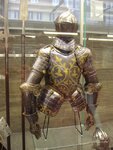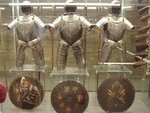- Thread starter
- #81
Navigation
Install the app
How to install the app on iOS
Follow along with the video below to see how to install our site as a web app on your home screen.
Note: This feature may not be available in some browsers.
More options
You are using an out of date browser. It may not display this or other websites correctly.
You should upgrade or use an alternative browser.
You should upgrade or use an alternative browser.
European Knight vs Asian Samurai
- Thread starter Soren
- Start date
Ad: This forum contains affiliate links to products on Amazon and eBay. More information in Terms and rules
More options
Who Replied?Matt308
Glock Perfection
Here are some pictures of som German Armour that I took at a museum near where I live.
Attachments
Joe2
Banned
It looks creepy, empty armour...
- Thread starter
- #85
Nice pics Adler ! 8)
Matt, no its not mine - wish it was though
Btw, talked to one of my friends yesterday about the swimming in armour issue, well he like you didn't believe it to be a very good idea - however I've read that there was actually a competiotion between knights back then which involved who could swim the furthest in armour - it actually evolved into a sport.
Matt, no its not mine - wish it was though
Btw, talked to one of my friends yesterday about the swimming in armour issue, well he like you didn't believe it to be a very good idea - however I've read that there was actually a competiotion between knights back then which involved who could swim the furthest in armour - it actually evolved into a sport.
Matt308
Glock Perfection
Yeah, conch diving.
- Thread starter
- #87
Matt308
Glock Perfection
Soundbreaker Welch?
Tech Sergeant
Ain't this fun?


jonsidneyb
Banned
- 21
- May 3, 2007
I have a bad feeling that I am going to bore alot of people here due to the way I think. I am not saying that my thinking is correct just that I have a certain approach to it.
In away I think that comparing to groups that never saw each other does not tell us much.
Do armies try to prepare to fight the enemy they expect to face? What I mean by this. My selection of tools and tactics will be centered on giving me an advantage over my likely enemy in the field. Also in the post Roman era of Europe were you not likely to face a mixed enemy. Heavy cavalry and Light cavalry both being used by the same side in different a different manner. Hordes of lightly armored men providing support for the heavily armored men. Archers being protected by Pikemen so they can stay in the fight longer when the distances close.
I think if you show the two armies what they will face in advance with ample time to prepare. The armies you see that take the field might look very different then what we originally saw. If I were either group you give me a year to prepare. I also have to factor in the enemy is also changing and I might be surprised by what I see when time comes.
I think the methods and equipment used evolves as we have contact with the enemy. If you do not get destroyed on the first time out if you have a weakness. You plug those weaknesses and perhaps the winner over the long run goes to he who adapts the best and makes the right changes to the mix.
I also think if we measure one on one combat capability we lose something. A battle is very different. In a battle I am just as worried about the guy that takes out targets of opportunity as I am the guy that is in front of me. Perhaps the most dangerous guy in a Mid Evil mixed battle is the guy that might not even kill anyone. Imagine the guy would is a capable fighter on a mixed battle field that chooses to avoid direct on equal terms combat. Instead he backstabs a couple of engaged fighters. Knocks one down while fighting another. Distracts another while he is engaged. This guy is effective not because he kills anyone but opens opportunities for others. That tells me that one on one measurements are only part of the battle.
The Japanese didn't do that well against the forces of both Gengis Khan and Kubla Khan. Nature however did do well against the Khans. That needs to ba analized I think as well. In the early days of post Roman European Combat Charles Martel was able to stop a Muslim invasion. Why?
I guess I think is that if we look at how to forces that are strangers to each other look does not tell us anything meaningful because given intellegence both sides may try and adapt.
In away I think that comparing to groups that never saw each other does not tell us much.
Do armies try to prepare to fight the enemy they expect to face? What I mean by this. My selection of tools and tactics will be centered on giving me an advantage over my likely enemy in the field. Also in the post Roman era of Europe were you not likely to face a mixed enemy. Heavy cavalry and Light cavalry both being used by the same side in different a different manner. Hordes of lightly armored men providing support for the heavily armored men. Archers being protected by Pikemen so they can stay in the fight longer when the distances close.
I think if you show the two armies what they will face in advance with ample time to prepare. The armies you see that take the field might look very different then what we originally saw. If I were either group you give me a year to prepare. I also have to factor in the enemy is also changing and I might be surprised by what I see when time comes.
I think the methods and equipment used evolves as we have contact with the enemy. If you do not get destroyed on the first time out if you have a weakness. You plug those weaknesses and perhaps the winner over the long run goes to he who adapts the best and makes the right changes to the mix.
I also think if we measure one on one combat capability we lose something. A battle is very different. In a battle I am just as worried about the guy that takes out targets of opportunity as I am the guy that is in front of me. Perhaps the most dangerous guy in a Mid Evil mixed battle is the guy that might not even kill anyone. Imagine the guy would is a capable fighter on a mixed battle field that chooses to avoid direct on equal terms combat. Instead he backstabs a couple of engaged fighters. Knocks one down while fighting another. Distracts another while he is engaged. This guy is effective not because he kills anyone but opens opportunities for others. That tells me that one on one measurements are only part of the battle.
The Japanese didn't do that well against the forces of both Gengis Khan and Kubla Khan. Nature however did do well against the Khans. That needs to ba analized I think as well. In the early days of post Roman European Combat Charles Martel was able to stop a Muslim invasion. Why?
I guess I think is that if we look at how to forces that are strangers to each other look does not tell us anything meaningful because given intellegence both sides may try and adapt.
jonsidneyb
Banned
- 21
- May 3, 2007
Another thought. Lets look at individual combat with no armor.
Kendo vs Rapier contest have been tried.
A guy from Spain ate up the Kendo man from Japan. Was it due to the men involved. Possibly but I think the rapier was in its element in this type of contest. I think the rapier is king of this kind of contest against almost any blade. Open ground one on one no armor.
Now lets stick the rapier into a battle even if no one has armor. I don't think I want many rapiers in my forces. For some specialized positons perhaps but I think the rapier is out of its element on the battlefield for the most part.
I think we need to look at armies the same way. Are they out of thier element. Can they change for the differences quickly and easily.
Kendo vs Rapier contest have been tried.
A guy from Spain ate up the Kendo man from Japan. Was it due to the men involved. Possibly but I think the rapier was in its element in this type of contest. I think the rapier is king of this kind of contest against almost any blade. Open ground one on one no armor.
Now lets stick the rapier into a battle even if no one has armor. I don't think I want many rapiers in my forces. For some specialized positons perhaps but I think the rapier is out of its element on the battlefield for the most part.
I think we need to look at armies the same way. Are they out of thier element. Can they change for the differences quickly and easily.
- Thread starter
- #92
Just one question:
How do you think it would be for a Samurai to fight an excellently trained and mobile 6.2" tall European Knight dressed like this ??:

My answer to the question would be: Absolutely terrorfying ! I mean not only is the Knight just as fast with his weapons, has a two edged sword and shield, but where the heck do you make a blow at him ?
The guy above is wearing very well tempered steel armour, something a Katana wouldn't want to come in contact with - a single impact could cause great damage to the Katana's fine cutting edge.
How do you think it would be for a Samurai to fight an excellently trained and mobile 6.2" tall European Knight dressed like this ??:
My answer to the question would be: Absolutely terrorfying ! I mean not only is the Knight just as fast with his weapons, has a two edged sword and shield, but where the heck do you make a blow at him ?
The guy above is wearing very well tempered steel armour, something a Katana wouldn't want to come in contact with - a single impact could cause great damage to the Katana's fine cutting edge.
jonsidneyb
Banned
- 21
- May 3, 2007
I do agree the Japanese would be in trouble in this matchup. They would have to make many alterations in order to cope.
I think it is mistaken however that European armies had the arI mored knight as the bulk of its forces. I thought they made up just a portion or even a minority of the fighting force. I thought most European armies utilized a mixed fighting force.
It does seem that the European knights are better protected from archers than the Japanese counterparts. The European knights are certain to have archers in the field with them. If I remember right it took about 10 years to get what was considered a competent useful archer prepared for his specialized task.
I think it is mistaken however that European armies had the arI mored knight as the bulk of its forces. I thought they made up just a portion or even a minority of the fighting force. I thought most European armies utilized a mixed fighting force.
It does seem that the European knights are better protected from archers than the Japanese counterparts. The European knights are certain to have archers in the field with them. If I remember right it took about 10 years to get what was considered a competent useful archer prepared for his specialized task.
jonsidneyb
Banned
- 21
- May 3, 2007
Thinking,
When full plate became more common didn't the Sword actually take a decline in use. War Hammers and the Battle Axe became more common on the field than before. When a number of guns came on to the scene full plate armor went onto the decline and swords became a more common sight again and the war hammers and battle axe went into decline.
If I am remembering this correctly, the sword was not the best weapon here.
When full plate became more common didn't the Sword actually take a decline in use. War Hammers and the Battle Axe became more common on the field than before. When a number of guns came on to the scene full plate armor went onto the decline and swords became a more common sight again and the war hammers and battle axe went into decline.
If I am remembering this correctly, the sword was not the best weapon here.
- Thread starter
- #95
You are not remembering correctly - the european swords were made specifically to be effective and withstand blows at plate armor. The most effective method was thrusting, however a well placed blow with the highly durable double edge sword could, while not penetrating the armor, break bones.
The sword was THE best infantry weapon throughout the middle ages.
However, war-hammers, maces, axes, halberds and chain maces were all effective as-well and could cause serious injuri to even the best protected knight with a well placed blow.
The sword was THE best infantry weapon throughout the middle ages.
However, war-hammers, maces, axes, halberds and chain maces were all effective as-well and could cause serious injuri to even the best protected knight with a well placed blow.
Matt308
Glock Perfection
One of the most common methods of killing mounted knights by unarmoured infantrymen, was to dismount them with fauchards/billhooks/halberds. And then make quick work of them since they were so encumbered.
And I think that jonsidneyb is on to something with respect to the sword. As platemail became more and more effective against the sword, this is what drove towards the use of weapons that relied less and less upon edged surfaces. Weapons that focused energy into a small point became much more efficient in penetrating platemail or causing crushing damage. Weapons such as the mace, flail, horseman's pick, war hammer, pike, fauchard and arrow suddenly were as effective or more effective than the sword "against armoured oppenents". The sword was still king against unarmoured or lightly armoured opponents.
Put a knight on horseback and force your fight to be up close and personal and the knight was damn near invincible. But force the fight to be at a distance or unhorse him and the tide quickly turns without mutual support to protect his flanks and rear. He was just too encumbered.
And I think that jonsidneyb is on to something with respect to the sword. As platemail became more and more effective against the sword, this is what drove towards the use of weapons that relied less and less upon edged surfaces. Weapons that focused energy into a small point became much more efficient in penetrating platemail or causing crushing damage. Weapons such as the mace, flail, horseman's pick, war hammer, pike, fauchard and arrow suddenly were as effective or more effective than the sword "against armoured oppenents". The sword was still king against unarmoured or lightly armoured opponents.
Put a knight on horseback and force your fight to be up close and personal and the knight was damn near invincible. But force the fight to be at a distance or unhorse him and the tide quickly turns without mutual support to protect his flanks and rear. He was just too encumbered.
renrich
Chief Master Sergeant
Being dressed in all that armor could be a problem if one had prostatitis. Is it true that English archers had arrows called bodkins that could penetrate plate armor? Some of the stuff I have read about the English longbow is fantastic.
- Thread starter
- #98
One of the most common methods of killing mounted knights by unarmoured infantrymen, was to dismount them with fauchards/billhooks/halberds. And then make quick work of them since they were so encumbered.
And I think that jonsidneyb is on to something with respect to the sword. As platemail became more and more effective against the sword, this is what drove towards the use of weapons that relied less and less upon edged surfaces. Weapons that focused energy into a small point became much more efficient in penetrating platemail or causing crushing damage. Weapons such as the mace, flail, horseman's pick, war hammer, pike, fauchard and arrow suddenly were as effective or more effective than the sword "against armoured oppenents". The sword was still king against unarmoured or lightly armoured opponents.
I somewhat agree with this Matt, however the European double edged sword was effective against even a heavily armoured opponent, the well tapered point of the sword being very effective for thrusting attacks. And the excellent balance of the European broad sword also meant it could deliver breathtakenly hard blows which while it wouldn't penetrate plate armor however would break bones. And keep in mind that plate-mail is no'where near as strong as plate armour and is very vulnerable to the thrusting and chopping blows of the broad sword. The medieval broad sword was made specifically to combat an armoured opponent and was very effective at doing so, however a sword and shield won't do you much good if you're charged by calvary - hence the development of most of the weapons you just mentioned. The reason the Rapier was developed was that as armour got stronger and stronger and covered more parts of the body only thrusting attacks were really effective and the chopping and cutting blows became less effective, however the need was still there so although the Rapier was mainly a thrusting weapon it also featured a double cutting edge for blows at the less armored parts only protected by light chain-mail.
The war-hammer, mace and chain mace were not new developments, and were used from the beginning of the middle ages as alternative yet effective weapons against armoured opponents. Similar for all these is they were concussion weapons, which relied purely on the force of impact to stun their target.
Put a knight on horseback and force your fight to be up close and personal and the knight was damn near invincible. But force the fight to be at a distance or unhorse him and the tide quickly turns without mutual support to protect his flanks and rear. He was just too encumbered.
A dismounted Knight is arguably just as dangerous as a mounted Knight - however if your point is that his fighting ability emmidiately after having been dismounted is low then I agree, anyone just having been dismounted would be in a bad spot emmidiately afterwards.
Glider
Captain
Being dressed in all that armor could be a problem if one had prostatitis. Is it true that English archers had arrows called bodkins that could penetrate plate armor? Some of the stuff I have read about the English longbow is fantastic.
They could but only at very close range. Normally they would aim at the head when close. This was weaker and the visor was often open when close to hand to hand combat. It opened for visibility as if your close to that kind of fight you need that visibility.
At longer ranges say 40-50 yards there were better targets such as the legs, groin, its a nasty no holds barred business. Horses were vulnerable at much longer ranges 100-150 yards no problem. It depended on the quality of the armour which varied significantly, the type of arrowhead and the pondage of the bow, plus dumb luck at long range as to what you hit.
[email protected]
Recruit
- 2
- Feb 11, 2009
...They could (pierce armor) but only at very close range. Normally they would aim at the head when close. This was weaker and the visor was often open when close to hand to hand combat. It opened for visibility as if your close to that kind of fight you need that visibility... At longer ranges say 40-50 yards there were better targets such as the legs, groin, its a nasty no holds barred business. Horses were vulnerable at much longer ranges 100-150 yards no problem...
Not quite true.
True, a well trained archer could hit a person's head at close range. However, archers in mass would never aim for the head, it is just too small a target to be practical. English longbows are lethal against plate armor out to about 300 yards, thanks to a special (arrow)head they used with a metal disk that would push the tip into the armor. At close range, archers would usually run, not fire. But that is pointless, knights didn't use the longbow.
However, I doubt either the knight or samurai would engage with ranged weapons. While both knight and samurai used ranged weapons (crossbow for knight) few relied on them. Though, I would give a ranged battle to the samurai, because the bow is more rapid fire than a crossbow. I do question whither either could inflict a mortal blow through the other's armor.
As for a fight on foot, I believe that the fight would be a close, bloody one, finally decided by a mixture of luck and skill. Though I think that the longer the fight went on, the greater the chances for the Samurai. The knight would tire and become much easier to kill. That being said, the shock value of a six foot man in shiny plate armor, to a small, five foot asian man would be immense. If the knight pressed his advantage I believe he would have a decent chance to take the field.
If by unlikely chance both were to meet each other on mount, I would give the fight to the knight. Few weapons beat a twenty foot lance in a charge.
So my vote? 2 to 1 the Knight.
Live with honor, or with honor die.
Users who are viewing this thread
Total: 1 (members: 0, guests: 1)
Similar threads
- Replies
- 0
- Views
- 1K

